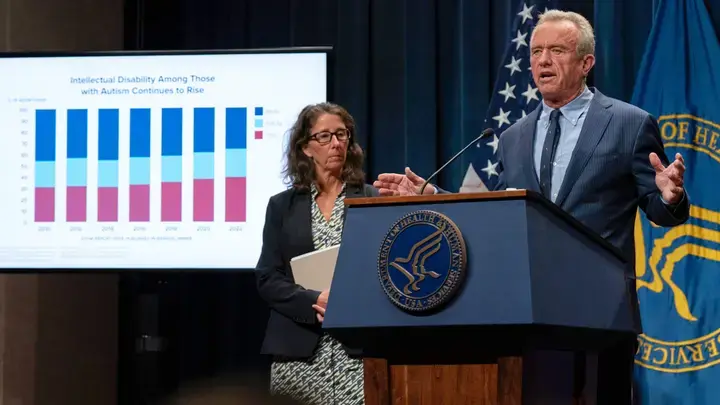In a controversial press conference on April 16, 2025, U.S. Health and Human Services Secretary Robert F. Kennedy Jr. asserted that autism is “preventable,” focusing exclusively on environmental toxins while dismissing genetic factors as a “dead end.”
RFK Jr. Autism Claims
His remarks followed the Centers for Disease Control and Prevention’s report showing autism prevalence at 1 in 31 eight‑year‑olds in 2022, up from 1 in 36 in 2020.
Kennedy vowed to commission exhaustive studies into substances like mold, food additives, and parental obesity, promising preliminary findings by September 2025. . Leading scientists immediately criticized the “preventable” label, emphasizing that autism is a complex neurodevelopmental condition driven by both genetic and environmental factors, and that there is no evidence to suggest true prevention is possible.

What Is Autism?
Autism spectrum disorder (ASD) is a developmental disability characterized by differences in brain development that affect social communication, behavior, and learning patterns. According to the CDC, ASD affects children across all racial, ethnic, and socioeconomic groups and is nearly four times more common in boys than girls. The CDC’s Autism and Developmental Disabilities Monitoring Network reported a steady rise in autism prevalence from 1 in 150 in 2000 to 1 in 31 in 2022, attributing much of this increase to improved screening, broader diagnostic criteria, and greater public awareness.
What Causes Autism?
Decades of twin studies and genetic research indicate that ASD is highly heritable, with genetics accounting for up to 80% of risk in some analyses. Scientists also acknowledge that environmental factors—ranging from parental age and maternal health conditions to prenatal exposures—may interact with genetic susceptibility to influence ASD development. However, no single toxin or exposure has been definitively linked to autism onset, and findings on environmental risk factors remain small, hard to replicate, and often context‑dependent.
Is Autism Preventable?
The consensus among public health experts is that autism is not preventable in the traditional sense of eradicating a disease. While early detection and intervention can markedly improve outcomes—enhancing communication skills and adaptive behaviors—there are no evidence‑based measures that can prevent ASD from occurring. Claims of prevention risk stigmatizing autistic individuals and diverting resources from support services and research into therapies and accommodations.
Research Initiatives and Timeline
Kennedy announced that the NIH will issue grants to universities and research institutes to “follow the science” on environmental contributors to autism, with preliminary answers expected by September 2025. These studies will examine factors like mold, pesticides, water contaminants, maternal obesity, and medical practices including prenatal ultrasounds. The HHS will centralize autism monitoring under a new Administration for a Healthy America to track real‑time data and ensure coordinated efforts across agencies.
Scientific Community Response
Researchers swiftly rebutted Kennedy’s all‑or‑nothing stance. Dr. Catherine Lord of UCLA affirmed that hundreds of genetic mutations are known contributors to ASD and that genes play a “clear” role in autism risk. Dr. Eric Fombonne called the notion of prevention “ridiculous,” noting that autism is not an infectious disease that can be halted through toxin avoidance . The Autism Science Foundation and Autism Speaks both issued statements underscoring that improved diagnostics and reduced stigma—not environmental toxins—are the most convincing explanations for rising prevalence.
Robert F. Kennedy Jr.’s pronouncement that autism is “preventable” has reignited debates over the origins of ASD and the balance between genetic and environmental research. While his initiative could mobilize federal support for underexplored environmental studies, experts caution that dismissing genetic contributions and vaccine safety data undermines a comprehensive understanding of autism.
The nation awaits his department’s findings this September, as the broader scientific community continues to advocate for a multi‑factorial approach that embraces both genetic insights and environmental investigations to support autistic individuals and their families.


